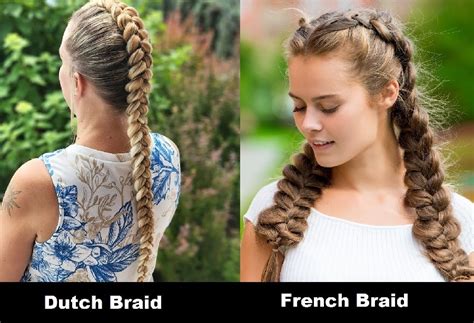Introduction
With countless hair-styling techniques vying for attention, two timeless braids reign supreme: the Dutch braid and the French braid. Both intricate and captivating, these braids elevate any look with their captivating beauty and versatility. This comprehensive guide explores the intricacies of each braid, delving into their history, techniques, differences, and intricacies.

Dutch Braid: A Reflection of Dutch Heritage
Originating in the quaint countryside of the Netherlands, the Dutch braid holds a special place in Dutch culture. Known as “vlecht” in Dutch, it has been adorned by generations of women, symbolizing unity, strength, and a deep connection to their heritage.
French Braid: A Parisian Masterpiece
The French braid, or as the French call it, “tresse,” emerged in the bustling streets of Paris during the 16th century. This elegant and sophisticated braid quickly captured the hearts and imaginations of fashion-forward women, becoming a timeless symbol of French chic.
Dutch Braid: An Inside-Out Adventure
Unlike its French counterpart, the Dutch braid begins with an inside-out technique. Instead of weaving the outer strands over the center, the Dutch braid incorporates them underneath, creating a raised and textured effect that stands out from the scalp.
French Braid: A Classic Within Reach
The French braid, on the other hand, follows a more traditional approach. Its outer strands are woven over the center, resulting in a flatter, intricate, and delicate braid that seamlessly blends into the hair.
A Comparison of Characteristics
| Feature | Dutch Braid | French Braid |
|---|---|---|
| Starting Point | Inside-Out | Outside-In |
| Appearance | Raised, Textured | Flat, Intertwined |
| Complexity | Slightly More Complex | Relatively Easier |
| Versatility | Casual and Formal Settings | Formal and Elegant Occasions |
Dutch Braid: Pros and Cons
Pros:
- Creates volume at the roots
- Adds texture and interest to hair
- Ideal for casual and sporty styles
Cons:
- Can be more time-consuming to braid
- Requires some practice to master
French Braid: Pros and Cons
Pros:
- Elegant and sophisticated appearance
- Suits formal and special occasions
- Relatively easy to learn and execute
Cons:
- Can be more difficult to create volume
- May not be suitable for all hair types
Dutch Braid Mistakes to Avoid
- Pulling the strands too tightly, resulting in discomfort.
- Neglecting to keep the tension even throughout the braid.
- Starting with uneven sections of hair, leading to an uneven braid.
French Braid Mistakes to Avoid
- Weaving the strands too loosely, compromising the braid’s integrity.
- Incorporating too much hair into each section, resulting in a bulky braid.
- Failing to cross the strands smoothly, creating a tangled and messy look.
1. Which Braid is More Difficult to Master?
The Dutch braid is generally considered slightly more complex to learn due to its inside-out technique.
2. When is it Best to Use a Dutch Braid?
The Dutch braid is ideal for creating casual and sporty styles that add volume and texture to the hair.
3. When is it Best to Use a French Braid?
The French braid is perfect for formal and elegant occasions, lending a sophisticated and timeless touch to any hairstyle.
4. Can I Braid My Own Hair with These Techniques?
Yes, with practice and patience, both Dutch and French braids can be mastered on your own hair.
5. What are Some Creative Uses for Dutch and French Braids?
- Dutch Braided Halo: Create a celestial halo by wrapping a Dutch braid around the head as a headband.
- French Braided Bun: Elevate the classic bun by securing it with a French braid for a polished and intricate effect.
- Dutch Braided Pigtails: Give pigtails a playful upgrade by embellishing them with Dutch braids.
Dutch and French braids stand as true hair-styling masterpieces, offering an enchanting blend of beauty and versatility. While their techniques vary, both braids empower us to express our creativity, enhance our natural beauty, and add a touch of timeless elegance to any occasion. Embrace the art of braiding and let these intricate creations transform your hair into a captivating tapestry of style and grace.
